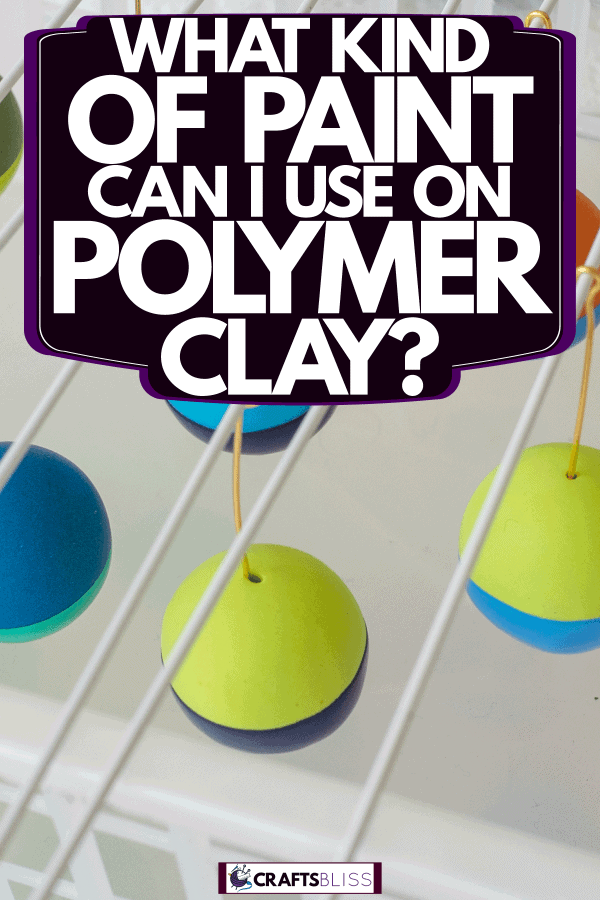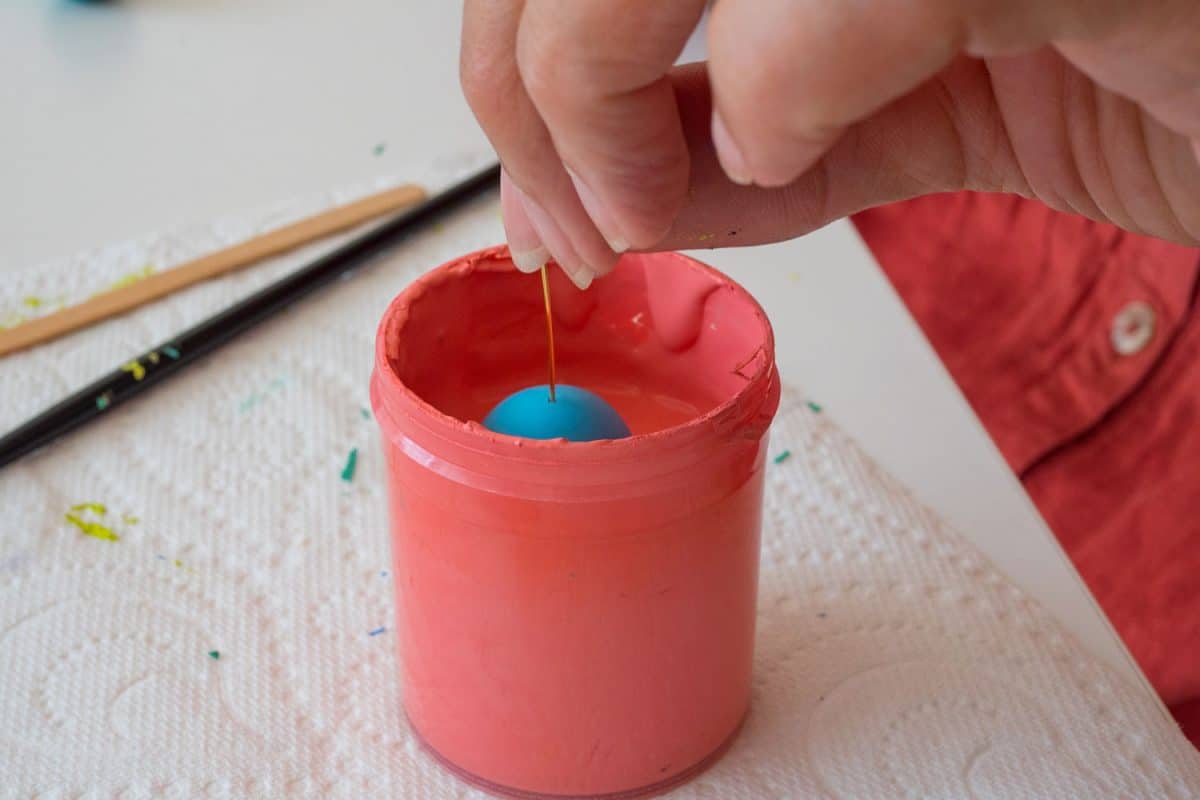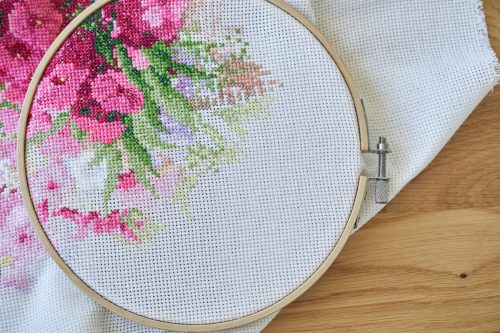Polymer clay is a popular medium for makers in all crafts. Whether you're just starting to use polymer clay or are thinking about painting the pieces you already made, you might wonder what paint you can use on polymer clay. We have done the research for you so you can be sure that you are using the correct paint on your polymer crafts.
Acrylic paint is the best paint for polymer clay. However, you can use other paints on polymer clay as well, including:
- Oil paint
- Watercolors
- Alcohol ink
Each type of paint or coloring will yield a different result. If you'd like to learn more about each type of paint and how it works on polymer clay, we invite you to continue reading as we explain each paint type in more depth.

Paint Types For Polymer Clay
Acrylic Paint
Acrylic paint is by far the most highly recommended paint for polymer clay. However, not all acrylic paint is created equally. Heavy-bodied acrylic is ideal for polymer clay application, but any water-based acrylic paint can do the job.
Heavy-Bodied Acrylic
When you go into any craft store, there is a section of artist-quality paints. These paints are more expensive than paint in other store sections and located alongside other professional quality supplies. It is there that you will find the heavy-bodied acrylics. Heavy-bodied acrylics are easy to apply to clay and provide better coverage than basic acrylic paints.
Click here to see this heavy-bodied acrylic paint on Amazon.
General Purpose Acrylic
If you are not a professional artist, you might have more experience with general purpose acrylics. They come in a variety of finishes and colors that are suitable for polymer clay.
General acrylic paints do not have the smooth one-coat coverage of the heavy-bodied acrylics, so more coats will be necessary. You may even find that you need to finely sand your clay piece before painting to help the paint bond better to the clay. While general acrylics require a bit more work than heavy-bodied acrylics, they can be used to create equally beautiful pieces.
Click here to see this acrylic paint set on Amazon.
Oil Paint
Oil paint can be used on polymer clay, but it requires more skill and patience. If you want to experiment with oil paint, be sure to choose a linseed oil-based paint rather than one that contains petroleum. Oil paints take a long time to dry, and using a petroleum-based paint will make the process longer or prevent the piece from drying completely.
Because of the long drying time, you should not treat oil paints with any varnish or sealer. Again, using these products may prevent your piece from being able to completely dry.
Take a look at this video to see an example of oil painting on polymer clay:
Oil paint drying times can be unpredictable, even if you purchase the correct type for polymer clay. If you are making pieces to sell, you may not be able to wait months for your pieces to dry before putting them up for sale.
Before diving into oil-painted clay work, take the time to experiment with different techniques and see how long they take to dry. Take note of your test pieces to find out how long they take to dry, and make sure they are not sticky once they have dried. If they are sticky after they have dried, the paint is not going to work for your clay.
Click here to see these oil paints on Amazon.
Watercolors
Watercolors are another option that requires some testing and preparation before using it on polymer clay. When using watercolors on clay, you cannot expect the full coverage that acrylics and even oil paints can achieve.
Instead, you can use them to highlight details or create a textured look. Like with oil paint, you will want to test the watercolors on a piece of pre-baked clay to see how the clay reacts to the paint and practice getting your desired effect.
While you want to test on pre-baked clay, watercolors can be used on clay before or after the baking process. Experiment with both options to see which method works best for you. You do not have to seal clay painted with watercolors, but you can if you prefer to.
Click here to see this watercolor set on Amazon.
Alcohol Ink
Of course, alcohol ink isn't technically a type of paint. However, you can use it quite effectively on polymer clay. Rather than creating a painted look like the different types of paints will achieve, use alcohol ink to create a stained look.
While this process may be messy, alcohol ink is more forgiving than any of the paint options. You can apply it on baked or unbaked clay, but if you use it after the clay is already baked, you can simply wipe off the ink and try again. Alcohol ink does not need to be sealed, but you can add a glaze to create a glossy look when you are finished.
Click here to see this alcohol ink on Amazon.
Do I Need To Seal Acrylic Paint On Polymer Clay?
While you may seal acrylic paint on polymer clay, you don't have to. Polymer clay takes acrylic paint well, and you can paint the pieces before or after you cure them in the oven. However, if you choose to seal your pieces after you paint them, they will have an attractive glossy finish.
How Do You Seal Acrylic Paint Onto Polymer Clay?
Sculpey, a popular polymer clay retailer, recommends using the following process for sealing your piece:
- Begin the process with a piece that has already been painted, cured, and cooled.
- Paint a thin coat of your desired sealer onto your piece.
- Allow the first coat to dry for 30 minutes.
- Add 1-2 more thin coats allowing each coat to dry for 30 minutes before adding a new coat.
- Allow your piece to dry completely.
How To Choose A Sealer
There are many different sealer options available, made by numerous companies. Take the time to research and read the packaging before choosing a sealer.
Brand
Some polymer clay manufacturers, such as Sculpey, offer sealers to be used specifically for their products. To ensure you are using the correct sealer, you may want to choose one made by your clay's manufacturer if one is offered.
If that is not an option, read the sealer's packaging to ensure that it is compatible with polymer clay and the type of paint you are using.
Finish
The sealer comes in a matte or glossy finish. As the name suggests, a glossy sealer will give your piece a shiny finish. A matte sealer does not reflect any light, so it will have a flat finish that is not shiny. The finish you should choose depends on what final look you want your piece to have.
Should You Paint Polymer Clay Before Or After Baking?

You can do either one! Polymer clay can be painted before or after baking, depending on your preference.
Before
Because polymer clay does not expand or shrink when baking, you can paint the clay before it is baked without sacrificing the design's integrity. The advantage of painting before you bake your clay is that the texture of the clay will be naturally rough. Therefore, the paint is more likely to stick to the clay.
After
If you choose to paint your piece after you've baked it, it is recommended to use water-based acrylic paint and finish it with a sealer. The sealer will prevent your piece from chipping since the paint hasn't bonded to the clay in the baking process.
Summary
Acrylic paint is easily the most popular paint option for polymer clay, but it is far from the only option available. When trying a new paint or colorant, keep in mind that most other options are not as straightforward to use as acrylic paint. You will want to take the time to experiment with the new technique on a test piece until you achieve your desired result.
Now that you have learned the best way to paint your polymer clay pieces take a look at these articles for more inspiration:
15 Cool Polymer Clay Christmas Ornament Ideas








![Read more about the article How To Use Epoxy Resin For Crafts [7 Great Ideas]](https://craftsbliss.com/wp-content/uploads/2021/05/A-breathtaking-and-stunning-looking-wooden-chestnut-table-with-an-epoxy-resin-design-in-the-middle-500x333.jpg)

![Read more about the article Why Is My Crochet Blanket Curving? [And How To Fix It]](https://craftsbliss.com/wp-content/uploads/2022/04/Crochet-blanket-focus-500x333.jpg)
